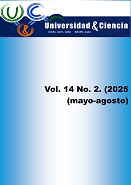Prevalencia de Oesophagostomum en cabras faenadas en un camal de Ecuador implicaciones en salud animal
DOI:
https://doi.org/10.5281/zenodo.15384431Palavras-chave:
cabras, faenado, parásito, prevenciónResumo
Introducción: La parasitosis gastrointestinal principalmente causadas por nematodos en animales domésticos, como las cabras (Capra aegragus hircus), no solo afecta su salud individual, sino también la rentabilidad de las explotaciones ganaderas. La Oesophagostomiasis provoca diarrea grave en el huésped debido a los daños tisulares que ocasiona en el intestino grueso de todas las especies animales afectadas. Objetivo: Determinar la prevalencia del parásito Oesophagostomum spp. en cabras sacrificadas en el matadero municipal de Ambato, utilizando muestras de heces, y analizar los daños que esta parasitosis ocasiona en el tracto gastrointestinal. Método: Se recopilaron y analizaron muestras de heces de un total de 274 cabras de las cuales 25 eran machos y 249 hembras, en diferentes estadios de gestación. La investigación se basó en un tipo de estudio de carácter cuantitativo y observacional. Se recolectaron muestras de materia fecal con el propósito de identificar parásitos gastrointestinales y coccidias, así como parásitos hepáticos, pulmonares o larvas. Resultados: La carga parasitaria, encontrada indica que las hembras presentaban una mayor susceptibilidad a las infecciones parasitarias con 516.024,45 huevos-gramo-heces con un total de 249 cabras de sexo hembra en un lapso de 6 meses, en comparación con los machos que presentaron 41.000 huevos-gramo-heces en 25 machos en 6 meses. Esto podría explicarse por su papel fundamental en la economía de las personas que las crían, lo que lleva a una mayor exposición a las fuentes de infección en el medio ambiente. Conclusión: El estudio muestra una situación preocupante en cuanto a la alta prevalencia de parasitosis por Oesophagostomum en las cabras faenadas, alcanzando el 100 % de los animales examinados.
Downloads
Referências
ALKaisy, Q. H., Al-Saadi, J. S., AL-Rikabi, A. K. J., Altemimi, A. B., Hesarinejad, M. A. y Abedelmaksoud, T. G. (2023). Exploring the health benefits and functional properties of goat milk proteins. In Food Science and Nutrition, 11(10), 5641–5656. John Wiley and Sons Inc. https://doi.org/10.1002/fsn3.3531
Bravo, L. X. (2019). Estimación de la frecuencia de lesiones intestinales de ovinos faenados en la EMRAQ-EP, con enfoque en el parásito Oesophagostomun spp. Mediante métodos anatomopatológicos y coproparasitarios. [Universidad de las Américas]. In 2019. https://dspace.udla.edu.ec/handle/33000/11016
Cáceres, M. V., Pinedo, R. Y. V. y Chávez, A. V. (2021). Gastrointestinal nematodiasis in goats from Ica, Perú. Revista de Investigaciones Veterinarias del Perú, 32(5). https://doi.org/10.15381/rivep.v32i5.21342
Charlier, J., Hoste, H. y Sotiraki, S. (2023). COMBAR -Combatting anthelmintic resistance in ruminants. In Parasite, 30. EDP Sciences. https://doi.org/10.1051/parasite/2023006
Dayenoff, P. M., Dri, P., Macario, J. E., Pizarro Castaño, J. M., Silva Jarquín, J. C., Andrade Montemayor, H. y Jaeggi, L. (2020). Morphological characteristics of the Goat Creole of the South of Mendoza, Argentina. Ciencia Veterinaria, 22(2), 97-118. https://doi.org/10.19137/cienvet202022202
Gonzalez, R., Perez, C., Torres, G., Mendoza, O. y Arece, J. (2011). Prevalencia de parásitos gastrointestinales en ovinos sacrificados en un rastro de Tabasco, México. Veterinaria México, 42(2), 125-135.
Hatam Nahavandi, K., Carmena, D., Rezaeian, M., Mirjalali, H., Rahimi, H. M., Badri, M., Vafae Eslahi, A., Shahrivar, F. F., Rodrigues Oliveira, S. M., Pereira, M. de L. y Ahmadpour, E. (2023). Gastrointestinal Parasites of Domestic Mammalian Hosts in Southeastern Iran. Veterinary Sciences, 10(4). https://doi.org/10.3390/vetsci10040261
Huynh, T., McKean, E. L. y Hawdon, J. M. (2022). Mini-baermann funnel, a simple device for cleaning nematode infective larvae. The Journal of Parasitology, 108(4), 403-407. https://doi.org/10.1645/22-47
Jaramillo, A. (2016). Identificación y prevalencia de parásitos gastrointestinales en caprinos en la parroquia Garza Real del Cantón Zapotillo, provincia de Loja. [Universidad Técnica Particular de Loja].
Mishra, R., Dohare, D., Pashupathi M., Vijayasarathi, M. K., Yadav, P. y Wodeyar, D. S. K. (2024). Concurrent Infection of Oesophagostomum species in a Slaughtered Goat: A Case Report. Uttar Pradesh Journal of Zoology, 45(3), 187-192. https://doi.org/10.56557/upjoz/2024/v45i33888
Munguía, J., Navarro, R., Hernández, J., Molina, R. y Granados, J. (2018). Parásitos gastroentéricos, población haemonchus contortus en caprinos en clima semiárido de Bacum, Sonora, México. Abanico Veterinario, 8(3), 42-50. https://doi.org/10.21929/abavet2018.83.2
Nurdianti, N. (2023). Coccidiosis in Small Ruminant and Antiparasitic Activity of Essential Oils. Media Kedokteran Hewan, 34(1), 60-79. https://doi.org/10.20473/mkh.v34i1.2023.60-79
Pilarczyk, B., Tomza-Marciniak, A., Pilarczyk, R., Bombik, E., Seremak, B., Udała, J. y Sadowska, N. (2021). A comparison of the prevalence of the parasites of the digestive tract in goats from organic and conventional farms. Animals, 11(9). https://doi.org/10.3390/ani11092581
Potârniche, A. V., Cerbu, C., Olah, D., Trif, E., D’Amico, G., Györke, A., Mickiewicz, M., Nowek, Z., Czopowicz, M., Nadolu, D., Anghel, A. H. y Kaba, J. (2024). An Insight into Practices Associated with the Control of Internal Parasites in the Dairy Goat Herds of Romania: A Questionnaire Survey. Animals, 14(16). https://doi.org/10.3390/ani14162375
Reyes Guerrero, D. E., Olmedo Juárez, A. y Mendoza De Gives, P. (2021). Control and prevention of nematodiasis in small ruminants: Background, challenges and outlook in Mexico. In Revista Mexicana de Ciencias Pecuarias, 12, 186-204. INIFAP-CENID Parasitología Veterinaria. https://doi.org/10.22319/rmcp.v12s3.5840
Rodríguez Vivas, R. I., Grisi, L., De León, A. A. P., Villela, H. S., De Jesús Torres Acosta, J. F., Sánchez, H. F., Salas, D. R., Cruz, R. R., Saldierna, F. y Carrasco, D. G. (2017). Potential economic impact assessment for cattle parasites in Mexico. Review. In Revista Mexicana de Ciencias Pecuarias,8(1), 61-74. INIFAP-CENID Parasitologia Veterinaria. https://doi.org/10.22319/rmcp.v8i1.4305
Salas, R. Z., Vélez, R. V., Ospina, L. V. H., Osorio, L. R. y Echeverry, D. N. P. (2016). Prevalence of gastrointestinal nematodes in sheep and goat production systems under confinement, semi-confinement and grazing in municipalities of antioquia, Colombia. Revista de Investigaciones Veterinarias del Perú, 27(2), 344-354. https://doi.org/10.15381/rivep.v27i2.11647
Shohana, N. N., Dey, A. R., Rony, S. A., Akter, S., Karmakar, B. C. y Alam, M. Z. (2024). Comparison of the first time detected Oesophagostomum asperum with Oesophagostomum columbianum in sheep and goats in Bangladesh based on the trinity: Morphology, morphometry and genetic diversity. Saudi Journal of Biological Sciences, 31(5). https://doi.org/10.1016/j.sjbs.2024.103980
Zapata Chinga, M. M. (2022). Prevalencia de Parásitos Gastrointestinales caprinos (Capra aegagrus hircus) del distrito Querecotillo, Provincia de Sullana, Departamento de Piura Perú [Universidad Nacional Hermilio Valdizón]. https://hdl.handle.net/20.500.13080/7981
Downloads
Publicado
Como Citar
Edição
Seção
Licença
Copyright (c) 2025 Universidad & ciencia

Este trabalho está licenciado sob uma licença Creative Commons Attribution-NonCommercial-ShareAlike 4.0 International License.





















